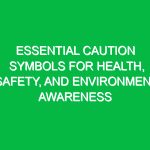Today, we are going to talk about an important topic that concerns our health, safety, and environment (HSE) – Insect Sting Allergies. It’s crucial to be aware of the risks associated with insect stings and how to protect ourselves in the workplace. Let’s dive into the details to ensure we all stay safe and informed.
Understanding Insect Sting Allergies
Firstly, let’s clarify what Insect Sting Allergies are in the context of HSE. Insect stings, such as those from bees, wasps, and hornets, can trigger allergic reactions in some individuals. These reactions can range from mild discomfort to severe, life-threatening conditions. It’s essential to recognize the signs of an allergic reaction and know how to respond in case of an emergency.
Identifying Symptoms
Common symptoms of an insect sting allergy include swelling, redness, itching, hives, and difficulty breathing. In severe cases, anaphylaxis can occur, leading to a rapid drop in blood pressure, loss of consciousness, and even death. If you experience any of these symptoms after an insect sting, seek immediate medical attention.
Preventive Measures
To protect yourself from insect sting allergies, follow these preventive measures:
- Wear appropriate clothing to cover exposed skin.
- Avoid using scented lotions or perfumes that may attract insects.
- Stay calm and still if an insect approaches you.
- Inspect your work area for nests or hives before starting tasks.
Potential Risks in the Workplace
Insect sting allergies can pose significant risks in our work environment, especially for those who work outdoors or in areas prone to insect activity. It’s essential to be vigilant and take necessary precautions to minimize the chances of an allergic reaction.
Emergency Response Procedures
In the event of an insect sting allergy emergency, here are the steps to follow:
- Call for medical assistance immediately.
- Administer any prescribed epinephrine auto-injector if available.
- Stay with the affected individual and monitor their condition until help arrives.
Compliance and Safety Regulations
As part of our commitment to safety, it’s important to adhere to relevant regulations and company policies related to insect sting allergies. Compliance with these guidelines not only ensures a safe working environment but also fulfills our legal obligations to protect employees from potential hazards.
Conclusion
In conclusion, being aware of insect sting allergies and taking proactive measures to prevent and respond to allergic reactions is crucial for our well-being in the HSE domain. Remember, safety is everyone’s responsibility, and by staying informed and prepared, we can create a safer workplace for all. Thank you for your attention and dedication to maintaining a safe working environment.


